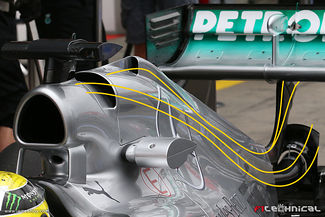(Lots of typos from phone in the below - can’t be bothered to edit but you get th idea!)
Sure I get it, and I also appreciate the pre-season-fanciful-rumours-that-turn-out-not-to-be-true as much as anyone!

Ok, so let me expand upon a thought i’ve been having for the last few years: given certain teams (particularly Red Bull and Mclaren) are very confident in the quality of their chassis but feel that they’re let down, to an unmanageable degree, by a lack of horsepower, i’m surprised that this concept of drag reduction - thereby at least partially compensating for a lack of horsepower- through fluidic switches hasn’t been pursued further.
Clearly there was merit to the concept of DRD (if you don’t know what i’m talking about, see
https://tianyizf1.wordpress.com/tag/f1-technical/) because so many teams tested versions of it:


...But we also know they encountered a lot og difficulty getting it working.
Nevertheless, I remained surprised in recent that, in these times of large power deltas, it was not a lucrative development avenue for those teams whose PU manufacturers are taking significant time attaining parity.
What I didn’t know until just now is that there had been a clarification to prevent the separate wastegate pipe being used in a similar fashion:
http://scarbsf1.com/?p=4488
All of which is just to underline my point that it wouldn’t surprise me if things like this are still being looked at; perhaps the rear wing proved very difficult to reattach the flow on but, given the 2017 regs introduced more drag producing bodywork to blow, this created a new draggy surface from which there would derive benefit from blowing?
Seems to me that an idea in F1 is seldom dropped completely.




